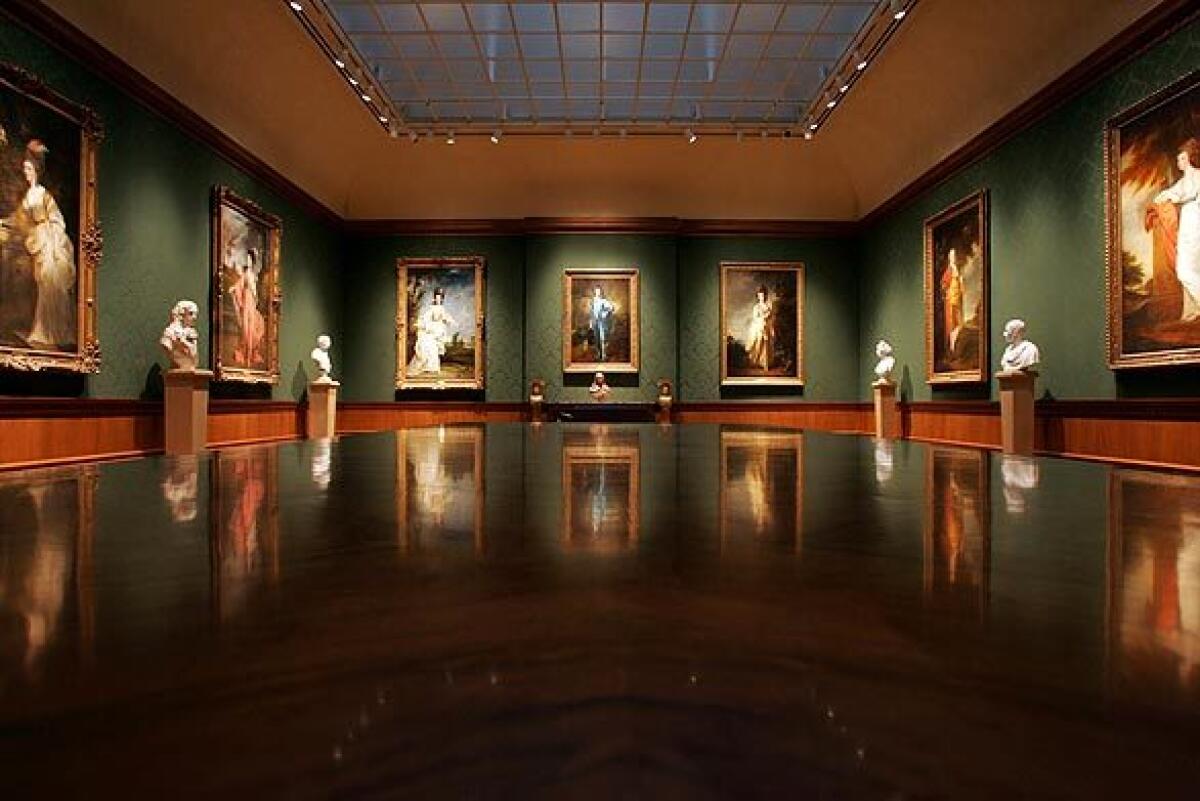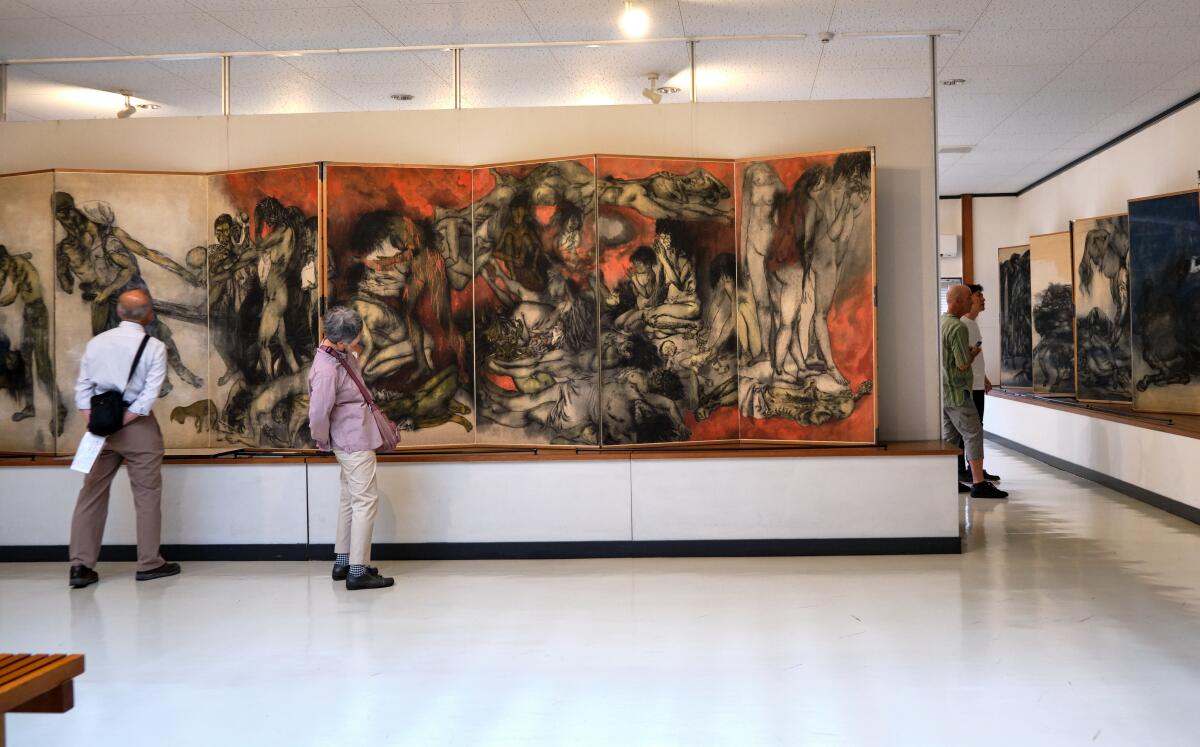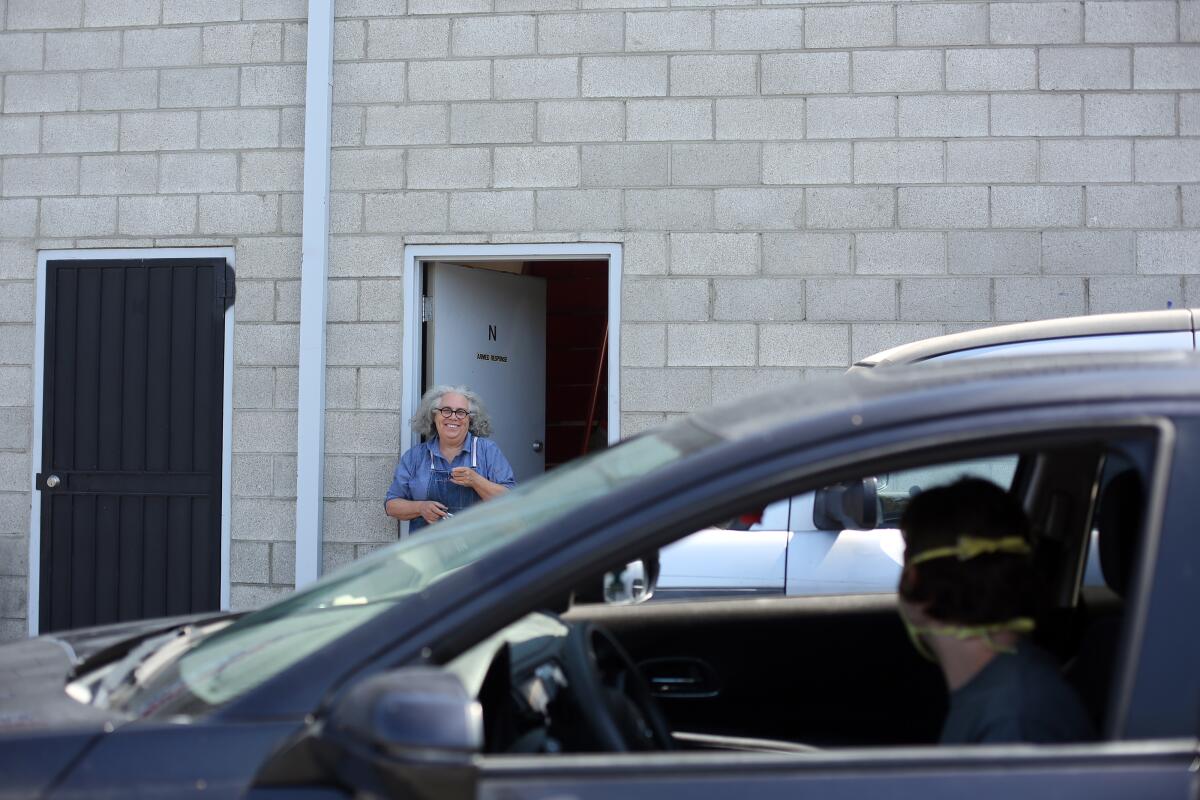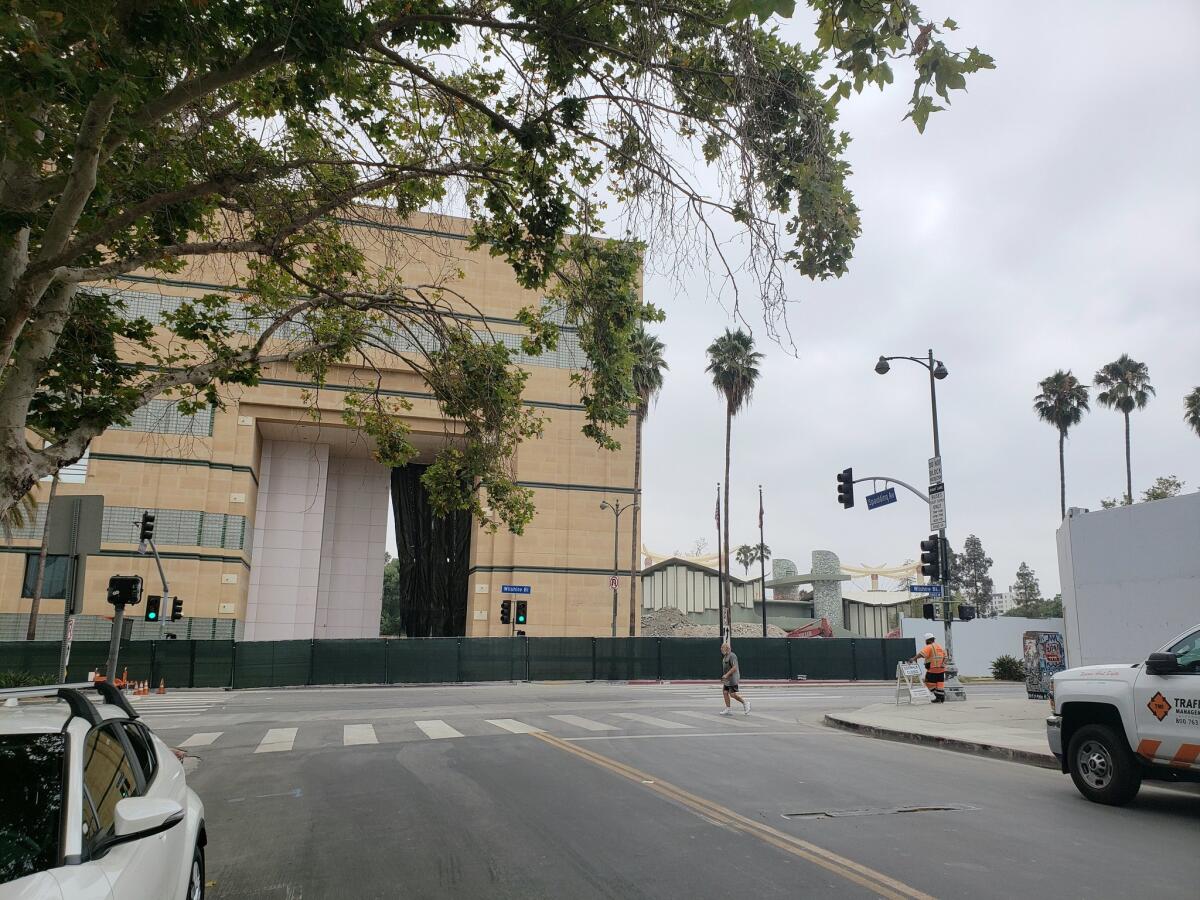Newsletter: Essential Arts: How singer Jessie Ware makes artful pandemic videos
- Share via
Greetings from my corner of the pandemic where I’ve been holding it together with a strong combo of chili dogs, Two Buck Chuck and violent Argentine thrillers. I’m Carolina A. Miranda, staff writer at the Los Angeles Times, with the week’s essential culture and music video news.
Dance dance revolution
Because we are all beauty-starved about now, The Times’ Makeda Easter comes through with a great piece on how British singer-songwriter Jessie Ware has managed to make sleek music videos that serve as showcases for dance — without the grainy Zoom aesthetics of the pandemic. Ware worked with the French choreography and art directing team I Could Never Be A Dancer (Carine Charaire and Olivier Casamayou) on shoots that feature solo dancers in an empty Wyoming bowling alley and a louche Parisian hotel room. The pandemic, says Casamayou, “is not going to kill creativity, it’s going to change it.” Lots to see here.
I want my MTV ... er, Disney+
Since we’re on the subject of music videos, it seems like a good time to talk about a little video you may have heard about: Beyoncé’s “Black Is King.”
Times TV critic Lorraine Ali describes it as “a pageant of sight and sound honoring the Black diaspora.” While culture critic Soraya Nadia McDonald, of the Undefeated, writes that the film “marshals the full power of Beyoncé’s celebrity to push Afrofuturism further into the pop culture mainstream.”
Andrew R. Chow at Time magazine profiles dancer Stephen “Papi” Ojo, the 22-year-old Nigerian-born dancer who appears throughout the film as the “blue man,” an ethereal spirit guide, and provided guidance on some of the film’s African dance moves. “A lot more people want to do research, learn the dances, or understand what part of Africa they’re from,” he says. “It’s just a beautiful thing to see.”
Plus, Alex Greenberger of ARTnews has a look at some of the art featured in the film. And Times fashion scribe Adam Tschorn rounds up the video’s many sumptuous looks.
Coronavirus and the arts
The Huntington in San Marino has laid off eight employees, including a high-level curator, reports Deborah Vankin. While the museum wouldn’t confirm whether Catherine Hess, the chief curator of European art (a key position) was among those laid off, Hess told The Times her last day will be Sept. 1. “Projections for the current fiscal year, which runs through June 30 and factor in a possible second wave of the virus and a new round of closures, are grim,” writes Vankin. “An estimated 70% drop in admissions, a 41% drop in general membership, a 52% drop in food services and facility rental income, and a 31% drop in retail sales.”

New York’s Metroplitan Museum of Art has made further cutbacks, laying off 79 employees and furloughing 181. In addition, 93 people took early retirement — leaving the staff 20% smaller than it was at the start of the pandemic.
The Radio City “Christmas Spectacular” has been canceled — the first cancellation since the show was first introduced in 1933.
In other coronavirus-related news: In Italy, it appears that “wine windows” — an architectural feature in buildings that date back to previous plagues — are making a comeback.
Art after Hiroshima
August marks the 75th anniversary of the atom bomb attacks on Hiroshima and Nagasaki during World War II. The experiences of survivors were recorded in mournful paintings made by artists Iri and Toshiko Maruki — paintings made at a time when images of the attack’s devastating human cost were being heavily censored. The artists died in 1995 and 2000, respectively, but their work on lives on at the Maruki Gallery, in a quiet suburban neighborhood outside of Tokyo. Contributor Jeff Spurrier pays a visit to this site of remembrance.

Listening tour
Times classical music critic Mark Swed is deep listening. This week, he turns his attention to the work of composer Pauline Oliveros, examining, among other works, the early 1980s piece “The Well & The Gentle.” The score, Swed notes, consists of a scale of seven pitches, a five-pointed star with five words that move clockwise — “Listen, Soar, Support, Match, Merge,” and it asks that performers “dig deep into the well of their own being.” One of the composer’s revelations is “that the whole body listens” and that you can also “listen to your body, which is its own percussion instrument.”
Make the most of L.A.
Get our guide to events and happenings in the SoCal arts scene. In your inbox every Monday and Friday morning.
You may occasionally receive promotional content from the Los Angeles Times.
While you’re listening, you can catch the rest of Swed’s “How to Listen” series right at this link.
The art of impersonations
Theater critic Charles McNulty is listening to — and looking at — the many impersonations of President Donald J. Trump that have arisen on social media. “Trump is without question the biggest boon to the mimics since Nixon,” says McNulty. And “the best burlesques” of 45 can be found on TikTok, YouTube and Twitter by figures such as Sarah Cooper and J-L Cauvin. These short video clips, he writes, “provide vivid X-rays into the hobgoblin mind and carnival barker manner of our reality-TV commander-in-chief.”
ICYMI, Times TV writer Greg Braxton had a great profile on Cooper back in June.
Portrait time
Shortly after the safer-at-home orders landed in March, artist Ian Byers-Gamber began hitting the road with a pair of bulky film cameras to make portraits of the L.A. arts community in a time of pandemic. Since then, he has captured dozens of L.A. artists from the window of his Honda HR-V, the car itself often serving as a prominent framing device. I recently tagged along on a visit to artist Alison Saar‘s studio in North Hollywood.

On a side note: Byers-Gamber has introduced me to the world of super cute Instagram dogfluencers from Korea and Japan and it has become an ongoing internet addiction. May I introduce you to a few faves: @yorikokoro (omggggg), @cle_rheni (dogfluencers and high-end home design) and @bichon_joseph (a mood). You’re welcome.
Enjoying this newsletter? Consider subscribing to the Los Angeles Times
Your support helps us deliver the news that matters most. Become a subscriber.
Separately, Times intern Dessi Gomez reports on another photographer who has also turned his car into a roving studio: L.A.-based Brian Bowen Smith. The celebrity photographer hit the road in a 1958 Ford pickup with a Leica, capturing black-and-white images of pandemic life across the U.S. — including a masked Elvis in Vegas and the rapper Common in Beverly Hills. They will be compiled in a book titled “Drivebys.”
Essential image
Christopher Knight happened to be cruising past LACMA earlier this week and posted a demolition report on Twitter: the Bing and the Hammer buildings were almost entirely gone and all that remained was the facade of Hardy Holzman Pfeiffer’s Art of the Americas building.

A good follow-up: Kieran’s Odd Outings (@OddOutings on Twitter) captured the Art of the Americas building coming down.
Essential happenings
The art space Crenshaw Dairy Mart opened its doors in late February — only to have to close them shortly thereafter due to the pandemic. But the nonprofit community art space, founded by artists Patrisse Cullors, Noé Olivas and Alexandre Dorriz, has quickly turned its attention to digital programming. To commemorate Black August, a month of Black resistance, they have teamed up with filmmaker Damon Davis — co-director of “Whose Streets?” — for a series of artist conversations and an Instagram takeover that will be ongoing through Sunday.
Related: Matt Stromberg at Hyperallergic looks at how Crenshaw Dairy Mart and other projects, such as Lauren Halsey’s Summaeverythang, are using art as a tool of empowerment in South L.A.
Matt Cooper comes through with his 16 picks for weekend culture, including a benefit for the Youth Los Angeles Orchestra (featuring performances by YOLA, the L.A. Phil and Brandi Carlile), as well as socially distant concerts by the Los Angeles Chamber Orchestra. As always, you can find more listings on our Things To Do: Arts & Culture page.
If you need some programming for little kids: Joe Horse Capture, a curator and vice president at the Autry Museum, has been taking strange and interesting objects from the collection and asking a Zoom panel of kids what the heck they think it might be. There are weird sounds and Cheez-Its.
Passages
Warner Henry, a philanthropist who championed classical music in Los Angeles through the support of organizations such as the L.A. Opera, the L.A. Phil, the Los Angeles Chamber Orchestra and the Colburn School, has died at 82.
Eric Bentley, an influential theater critic who championed European dramas, and was no fan of Broadway, is dead at 103.
In other news
— In addition to the loss of life and property in the massive explosion of ammonium nitrate in Beirut’s port that devastated the city, many art spaces were destroyed.
— Times correspondent Nabih Bulos got caught just 500 yards from the explosion — and somehow survived it.
— A tourist in Northern Italy sat on a 200-year-old sculpture ... and broke its toes.
— Christopher Knight, who is one informative dude, pointed out this week that the Philam Life Building and Theater, a historic Modernist structure in Manila by Carlos Arguelles, will — sadly — not be around for much longer.
— I really enjoyed this essay by New York Times food critic Tejal Rao about the twilight of the “imperial chef” — which offers some interesting parallels to massive artist studios and architectural firms where workers churn out work in the name of a single individual.
— It pairs well with this terrific 2018 essay by architecture critic Alexandra Lange about why we should get rid of architect profiles.
— Taylor Renee Aldridge and Susan D. Anderson are joining the California African American Museum as curators.
— “A strange flex that prompts some compelling questions about style, poise, power and confidence.” Colony Little on the sumptuous portraits of Kennedi Carter.
— Bryony Roberts and Mabel O. Wilson have a fascinating essay about the Silent Protest Parade of 1917, a Black civil rights march held in New York City, and how it inspired a new work of performance in 2017.
— A new app from L.A. Dance Project mixes dance instruction with footage or performances and rehearsals.
— Wear a mask, but make it fashion: The Times has the best ones around, including a new artist series from MOCA.
And last but not least ...
Cardi B and Megan Thee Stallion have a naughty new song and it’s my dirty lady mood-lift for the weekend. Even better: California congressional candidate James P. Bradley “accidentally” listened to it and is, like, totally offended.
The biggest entertainment stories
Get our big stories about Hollywood, film, television, music, arts, culture and more right in your inbox as soon as they publish.
You may occasionally receive promotional content from the Los Angeles Times.




